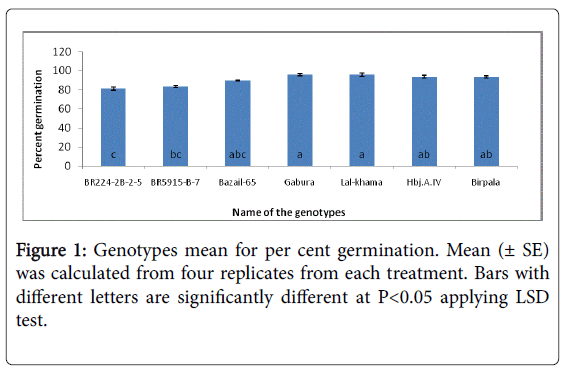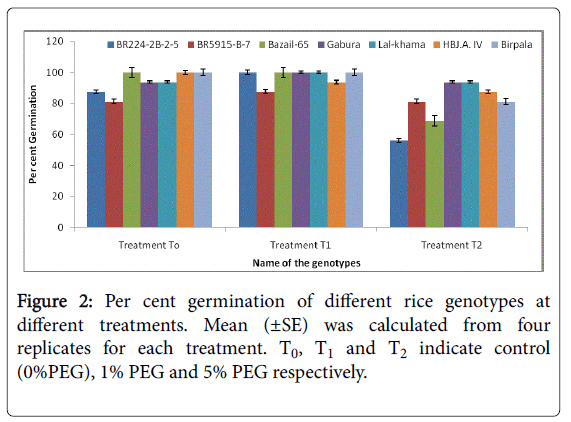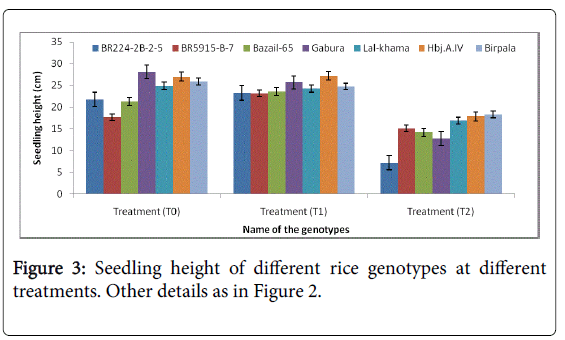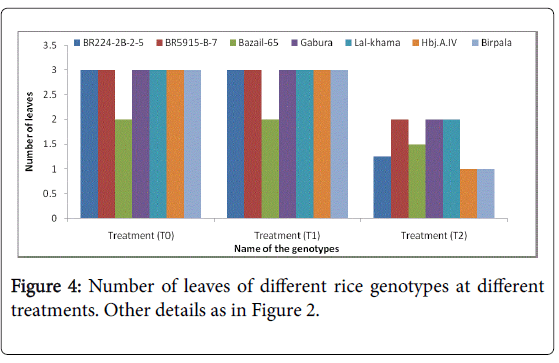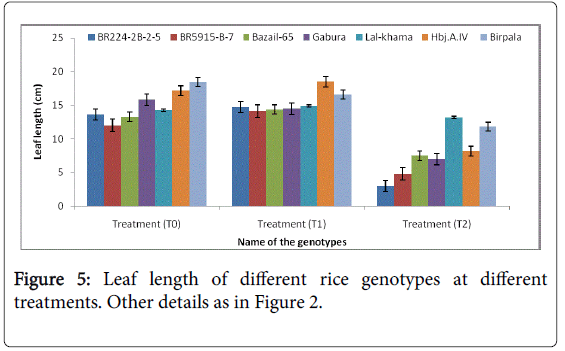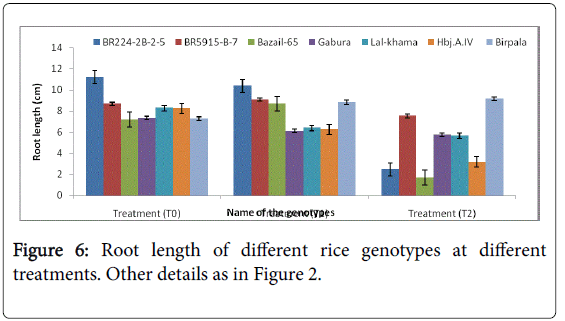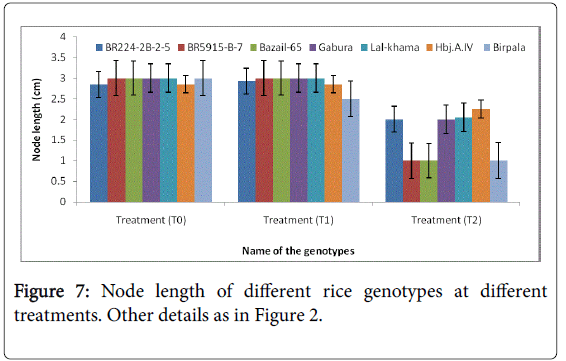Research Article Open Access
Assessment of Seedling Growth of Deepwater Rice Genotypes under Osmotic Stress Condition
Emam Ahmed MM1, Haque MM1*, Arif Hasan Khan Robin ABM2, Hossain MA2 and Biswash MR3
1Plant Breeding Division, Bangladesh Rice Research Institute, Gazipur 1701, Bangladesh
2Department of Genetics and Plant Breeding, Bangladesh Agricultural University, Mymensingh 2202, Bangladesh
3Adaptive Research Division, Bangladesh Rice Research Institute, Gazipur 1701, Bangladesh
- Corresponding Author:
- Md. Maksudul Haque
Scientific Officer (Golden Rice), Plant Breeding Division, Bangladesh Rice Research Institute, Gazipur 1701, Bangladesh
Tel: +8801723778056
E-mail: maksudulhq@gmail.com
Received Date: April 14, 2016; Accepted Date: August 18, 2016; Published Date: August 25, 2016
Citation: Emam-Ahmed MM, Haque MM, Robin AHN, Hossain MA, Biswash MR (2016) Assessment of Seedling Growth of Deepwater Rice Genotypes under Osmotic Stress Condition. J Rice Res 4:173. doi: 10.4172/2375-4338.1000173
Copyright: © 2016 Emam-Ahmed MM, et al. This is an open-access article distributed under the terms of the Creative Commons Attribution License, which permits unrestricted use, distribution, and reproduction in any medium, provided the original author and source are credited.
Visit for more related articles at Rice Research: Open Access
Abstract
The experiment was conducted to study the early establishment osmotic stress of advanced deep water rice. Severe parameters such as percent germination, seedling height, and number of leaves, leaf length, node length, and root length were studied for in vitro study. This study was conducted by MS medium supplemented with two treatments of PEG (1% and 5% PEG) and control (0% PEG). For percent germination, Bazail, HBJ.A.IV, and Birpala showed better performance with control (0%) but Gabura and Lalkhama performed better in both T1 (1% PEG) and T2 ( 5% PEG). The genotype Gabura showed more seedling height under control and HBJ.A.IV with T1 and T2. At 5% PEG, more number of leaves was found in BR5915-B-7, Gabura and Lalkhama. HBJ.A.IV and Lalkhama showed more leaf length and node length at T2. The genotype BR224-2B-2-5 was best and control and T1. But Birpala showed more root length at T2. The information generated in this study indicated that there is a close relationship between in vitro studies for the growth performance of the rice genotypes although significant variation was observed within the genotypes. Finally, the advanced genotype BR224-2B-2-5 may be a good source to meet the future challenge.
Keywords
Seedling Growth; Deep water; Osmotic Stress; Rice (Oryza Sativa L.)
Introduction
Rice (Oryza Sativa L.) is the most important and extensively cultivated cereal crops in Bangladesh. Rice has been considered as staple food and about 80% of the total cultivated lands in Bangladesh are used for rice cultivation [1]. Bangladesh is the world’s fourth largest rice producer. In the last three to four decades, great efforts in rice research and farming innovations were made to boost rice production. The country’s total production has also increased to about 33.3 million tons (milled rice) in 2011 whereas Indonesia, India, and China produced 44.31, 103.8 and 135.1 million tons respectively (FAO, 2011). Furthermore, rice alone contributes about 9.5% of the total agricultural GDP in the country. Among all crops, rice is the driving force of Bangladesh agriculture. In fact, food production in Bangladesh is dominated by a single crop (rice) and a single season (Boro, which accounts for over 60% of total rice production) [2].
Rice is considered as major crop in Bangladesh. It is not only the main source of carbohydrate but also provides 69.61% of calories and 56.15% of the proteins in the average daily diet of the people [3]. The rice production also increased steadily along with net food demands (rice and wheat) and reached 32.1 and 33.3 million tons in 2009 and 2010 [4].
Complete submergence annually affects about 16 million ha of rice in South and Southeast Asia, and about one third of the total rice growing area in Africa. The effect of damage caused by transient submergence is dependent on the characteristics of flood waters, including temperature, turbidity, concentration of dissolved gases, and extent of light penetration [5].
Deepwater rice (DWR) is grown in flooded conditions with water more than 50 cm (20 inch) deep. More than 100 million people in South and Southeast Asia rely on deepwater rice for their sustenance. Many districts of Bangladesh are flooded during the rice cultivation season every year and thus, curtail the national rice yield by causing severe damage to the rice cultivated field. Therefore, it is high time to select potential rice cultivars for breeding program to develop submergence tolerant as well as flash flood resistant rice variety [6]. The topographical situation along with availability of water and sub tropical climate constitutes an excellent habitat for rice cultivation in Bangladesh. In fact, there are different rice ecosystems, namely upland (direct seeded pre-monsoon Aus), irrigated (mainly, dry season Boro), rainfed lowland (mainly monsoon season transplanted Aman, medium-deep stagnant water up to 50-100 cm) [7].
Rice is a semi-aquatic plant and one of the most important crops cultivated in both tropical and temperate regions. DWR is grown in more than 50 cm water for one month or longer during the cropping season. Based on stature and depth of water, these are of two types: (i) traditional tall, and (ii) floating. Traditional tall cultivars are tall with long leaves, and grown at water depths between 50 and 100 cm; floating rice is grown in 100 cm or deeper situations. In Bangladesh most of the rice grown in the low lying areas during monsoon are floating rice, generally called as deepwater rice, locally known as broadcast aman, jolidhan, poushdhan etc. [8].
In Bangladesh deepwater rice covers an area of 0.48 million ha [7] where there is no other option to cultivate modern T. aman varieties. In haor and beel areas like Sunamganj, Sylhet, Habiganj, B. Baria, Faridpur, Gopalganj and Pabna, local deepwater rice varieties are cultivated which have low yield potential [8].
The depth of water in some areas can exceed 4 m as in floating rice areas. Apparently each of these types of floods requires specific adaptive traits, which necessitates the development of unique varieties [9]. Though DWR is cultivated in small areas with low yield, attention should be given to achieve breakthrough in yield potential. Many advanced lines of DWR having better yield potential have been developed by Bangladesh Rice Research Institute (BRRI).
Screening genotypes at seedling stages have several benefits, such as low cost, ease of handling, less laborious and getting rid of susceptible genotypes at earliest [10]. In vitro selection techniques involving the use of Polyethylene glycol (PEG), is one of the reliable methods for screening desirable genotypes and to study further the effects of water scarcity on plant germination indices [11,12]. PEG is a non-penetrate and non-toxic osmotic substance which can be used to lower the water potential of culture medium [13]. The selected abiotic stress tolerance rice cultivars have a potential of direct introduction in to farmer fields [14] or utilize them in breeding programs to develop abiotic stress tolerance rice cultivars [14,15].
Early establishment of crop is necessary for DWR to face the flood water throughout the growing season (typically one or two months). The crop established before monsoon begins or floodwater enters can withstand better in raising water level situation. Thus, effective crop growth can boost up total grain production at the end of the season. Crop improvement against moisture stress has been difficulty mainly for 1) lack of suitable screening technique that allows large population and 2) complexity in its arrival times and extents, since it occurs with different intensity and extent in different years. Growth study along with different plant structures is of utmost necessity for crop improvement under stress condition. Though DWR area is comparatively low compared to total rice area, there is necessity of working on it because there exist low lying rice areas where it is one and only option during Aman season.
If high yield potential DWR varieties are introduced, there will be significant increase in national rice production. Hence there is need of advanced breeding lines to select for a rice variety suitable for DWR areas. Considering the above facts, the present research studies was undertaken to fulfill the following objectives: To study the osmotic stress tolerance of newly developed advanced DWR genotypes through PEG treatment and to study the extent of variation of growth status of advanced rice genotypes under osmotic stress and actual field conditions.
Materials and Methods
The experiment (In vitro ) reported herein was carried out during the period from April, 2014 to May, 2014 in the Tissue Culture Laboratory of the Department of Genetics and Plant Breeding, Bangladesh Agricultural University, Mymensingh, Bangladesh. Seeds of seven DWR genotypes were collected from the laboratory of BRRI, Regional Station, Habiganj. Among them Hbj.A.IV and Birpala are local check variety. A description of genotypes used in the present study is presented in Table 1.
| Designation | Growing season | Origin/Source |
|---|---|---|
| BR224-2B-2-5 | B. Aman | BRRI, R/S, Habiganj |
| BR5915-B-7 | B. Aman | BRRI, R/S, Habiganj |
| Bazail-65 | B. Aman | BRRI, R/S, Habiganj |
| Gabura | B. Aman | BRRI, R/S, Habiganj |
| Lal-khama | B. Aman | BRRI, R/S, Habiganj |
| Hbj.A.IV (local check) | B. Aman | BRRI, R/S, Habiganj |
| Birpala (local check) | B. Aman | BRRI, R/S, Habiganj |
Table 1: Names, ecotypes and sources of seeds of the rice genotypes/ varieties.
The procedure for preparation of In vitro media
The procedure for preparation of In vitro media with different concentration of PEG 6000 is as follows:
Treatment of PEG: The PEG 6000 was applied at the rate of
T0=0% i.e. 0 g/100 ml medium (Control)
T1=1% i.e. 1 g/100 ml medium and
T2=5% i.e. 5 g/100 ml medium
Culture method: Sterilized mature seeds of seven rice genotypes were inoculated into vials with forceps each containing 10 ml MS medium with PEG at different concentration viz., T0=0% (control/no PEG), T1=1% PEG, T2=5% PEG with four replication. Cultures were maintained at 25°C with controlled lighting for a period for a day night cycle of 16 h/8 h (day/night).
Parameters under study
Percent germination:

Here, number of seed set for germination=4
Seedling height, number of leaves, leaf length, root length and node length: At the 21st day, the seedlings from the vial were taken out with the help of forceps and numbers of leaves were counted. Then seedling height, shoot length, root length and node length of three seedlings were measured in centimeter by a graduated scale and total length was calculated from the recorded data.
Statistical analysis: The recorded data were analyzed using Microsoft Statistical (MSTAT) program and Microsoft Excel wherever applicable. The experiment was arranged in Completely Randomized Design (CRD) and the collected data were analyzed following one way analysis of variance (ANOVA) technique and the mean differences were adjusted by Duncan’s Multiple Range Test (DMRT) and the ranking was indicated by letters.
Result and Discussion
The results of studies related to performance of rice genotypes growing under In vitro conditions and field conditions are presented and discussed in this chapter.
Percentage of germination
The results of analysis of variance for the characters per cent of germination is presented in Table 2. The genotype varied significantly for the characters per cent of germination and media supplemented with different concentration of PEG in the medium for above parameter was also significant (Table 2). The analysis of variance showed that genotypes and different moisture stress condition had conspicuous effect on per cent of germination.
| Sources of variance | Degree of freedom | Mean Square | |||||
|---|---|---|---|---|---|---|---|
| Percent germination | Seedling height | Number of leaves | Leaf length | Root length | Node length | ||
| Factor A (Genotype) | 6 | 431.55* | 70.57** | 1.08** | 53.50** | 15.85** | 0.52** |
| Factor B (Treatment) | 2 | 2239.58** | 855.59** | 16.29** | 393.97** | 89.43** | 16.10** |
| AB | 12 | 312.5 | 25.44** | 0.46** | 10.65** | 16.75** | 0.49** |
| Error | 83 | 183.53 | 6.27 | 0.03 | 3.87 | 2.16 | 0.03 |
Table 2: Summary of analysis of variance on per cent germination and some plant characters. *Significant at 5% level of probability, **Significant at 1% level of probability.
Response among the genotypes/varieties for germination
The mean squares of genotypes for per cent of germination are highly significant indicating the presence of adequate variability among the varieties for this parameter (Table 2). The results of genotype responses to PEG (for germination) are presented in Figure 1. Among the genotypes, Bazail-65, HBJ.A.IV, and Birpala showed better performance without PEG in the medium (T0) but Gabura and Lal-khama performed better in both T1 (1% PEG) and T2 (5% PEG) condition (Figure 2). Similar declines in seed germination have been reported in the literature [16,17].
Per cent of germination varied from 81.35 to 95.83. The highest per cent of germination was in varieties Gabura and Lal-khama (95.83) and the lowest in BR224-2B-2-5 (81.25) and there were significant differences among the genotypes (Figure 1).
Response of genotypes/varieties to different treatments
Mean squares due to different PEG treatments (T0=0% PEG, T1=1% PEG and T2=5% PEG) were highly significant (Table 2). The effect of different moisture stress level of medium is presented here (Table 3). The highest per cent of germination was in varieties Gabura and Lalkhama and the lowest in BR224-2B-2-5 and there were significant differences among the genotypes (Table 3).
| PEG concentration | Per cent germination |
|---|---|
| T0=0g/100 ml | 93.75a |
| T1=1g/100 ml | 97.32a |
| T2=5g/ 100 ml | 80.36b |
| LSD (0.05) | 7.235 |
| S.E. (±) | 2.56 |
Table 3: Mean effect of different PEG concentration on per cent of germination. * The values bearing different letters in the same column are significantly different at 5% level of probability.
Among the treatments, MS media containing 1% PEG showed best result for per cent germination i.e. 97.32, there was significant difference between T0 (control) and T2, and no significant difference was found between T0 (control) and T1 (Table 3). The treatment T1 better than control (T0) indicates osmotic stress response of the deepwater genotypes at certain level and it declines when concentration is high (5% PEG).
Effects of genotype×PEG treatment on germination
Mean squares due to interaction (genotype×treatment) were not significant (Table 2). Interaction effects of genotype and treatment on both the character are presented in Figure 2. Among the genotypes, Bazail-65, HBJ.A.IV, and Birpala showed better performance without PEG in the medium (T0). Gabura and Lalkhama performed better in both T1 (1% PEG) and T2 (5% PEG) condition (Figure 3). Among the genotypes, Bazail-65, HBJ.A.IV, and Birpala showed better performance without PEG in the medium (T0) but Gabura and Lalkhama performed better in both T1 (1% PEG) and T2 (5% PEG) condition (Figure 4). Similar declines in seed germination have been reported in the literature [16,17].
Plant Characters
The results of analysis of variance for plant characters have been presented in Table 2.
Response among the genotypes/varieties
The variety mean square was highly significant (Table 2) indicating the presence of adequate variability among the genotypes/varieties. Mean performance of the genotypes/varieties are presented in Table 4.
| Name of the genotype/variety | Seedlingheight (cm) | Numberof leaves | Leaf length (cm) | Root length (cm) | Node length (cm) |
|---|---|---|---|---|---|
| BR224-2B-2-5 | 17.45c | 2.42 b | 10.87 c | 8.02 a | 2.59 a |
| BR5915-B-7 | 18.67 bc | 2.67 a | 11.93 bc | 8.43 a | 2.33 b |
| Bazail-65 | 19.71 b | 1.83 c | 10.77 c | 5.87 b | 2.33 b |
| Gabura | 22.19 a | 2.67 a | 12.58 b | 6.40 b | 2.66 a |
| Lal-khama | 22.02 a | 2.67 a | 13.25 b | 6.78 b | 2.68 a |
| Hbj.A.IV | 24.03 a | 2.33 b | 15.83 a | 5.89 b | 2.65 a |
| Birpala | 22.99 a | 2.33 b | 15.80 a | 8.41 a | 2.17 c |
| LSD (0.05) | 2.04 | 0.13 | 1.60 | 1.20 | 0.15 |
| S.E. (±) | 0.72 | 0.05 | 0.57 | 0.42 | 0.05 |
Table 4: Mean performance of different genotypes/varieties for different plant characters. *The values bearing different letters in the same column are significantly different at 5% level of probability.
The seedling height varied from 17.45 to 24.03 cm and maximum seedling height (24.03 cm) was found for the variety Hbj.A.IV and minimum (17.45 cm) seedling height for BR224-2B-2-5 whereas Gabura, Lal-khama, Hbj.A.IV, and Birpala showed no significant difference. In case of number of leaves, the data showed a variation from 1.83 to 2.67 and many of the genotypes showed significant difference whereas maximum live leaves were found for the genotype BR5915-B-7, Gabura, Lal-khama and a few leaves in Bazail-65. Leaf length varied from 10.77 to 15.83 cm, the variety Hbj.A.IV & Birpala showed the maximum leaf length and Bazail-65 showed the minimum leaf length. Root length was not varied much like other parameters. It varied from 5.87 to 8.43 cm (Table 4). Node length was also varied significantly from 2.17 to 2.68 cm and the lowest node length was recorded for Birpala and the highest for Lalkhama (Table 4). Maximum seedling height was found for the variety Hbj.A.IV and minimum seedling height for BR224-2B-2-5 whereas Gabura, Lalkhama, Hbj.A.IV, and Birpala showed no significant difference (Table 4). Maximum leaves were found for the genotype BR5915-B-7, Gabura, Lal-khama, and minimum leaves in Bazail-65. Hbj.A.IV and Birpala showed highest leaf length and lowest leaf length for Bazail-65 (Table 4). Root length was not varied much like other parameters. The lowest node length was found for Birpala and the highest for Lalkhama (Table 4). Sandhu et al. [18] also reported that lowland indica were more sensitive to PEG stress by reducing seedling and root length.
Response of genotypes to MS medium supplemented with different treatment
Mean squares due to different treatments of PEG were significant for seedling height, node length, number of leaves, leaf length and root length (Table 2). The effect of media containing different treatment is presented in Table 5.
Among the three treatments, seedling height and number of leaves are significantly different from each other. For all characters T0 and T1 did not differ significantly (Table 5).
| PEG concentration | Seedling height (cm) | Number of leaves | Leaf length (cm) | Root length (cm) | Node length (cm) |
|---|---|---|---|---|---|
| T0=0g/100 ml | 23.81 a | 2.85 a | 14.94 a | 8.31 a | 2.95 a |
| T1=1g/100 ml | 24.57 a | 2.85 a | 15.39 a | 7.96 a | 2.89 a |
| T2=5g/ 100 ml | 14.64 b | 1.54 b | 8.68 b | 5.06 b | 1.61 b |
| LSD (0.05) | 1.33 | 0.09 | 1.05 | 0.78 | 0.1 |
| S.E. (±) | 0.47 | 0.03 | 0.37 | 0.28 | 0.03 |
Table 5: Mean effect of different treatments of PEG on plant characters. *The values bearing different letters in the same column on the table are significantly different at 5% level of probability.
Effect of genotype×PEG treatment on plant characters
Mean squares due to interaction (genotype×treatment) were significant (Table 2). Interaction effects of genotype and treatment on plant characters are presented in Figures 3-7. The genotype Gabura showed best performance in seedling height under control (T0) and HBJ.A.IV with T1 and T2 but Birpala recorded maximum seedling height with T2 (Figure 3). In case of number of leaves all the genotypes except Bazail-65 showed better performance with control (T0) and 1% PEG whereas BR5915-B-7, Gabura, and Lal-khama recorded the highest number of leaves at 5% PEG (Figure 4). The cultivar Birpala showed better performance in respect of leaf length at control (T0) whereas HBJ.A.IV and Lal-khama cultivar recorded the highest leaf length at T1 and T2 respectively (Figure 4).
The genotype Gabura showed best performance in seedling height when under control (T0) whereas HBJ.A.IV recorded the highest seedling height at T1 and T2 (Figure 4). In case of number of leaves all the genotypes except Bazail-65 showed better performance with control (T0) and 1% PEG (T1) but maximum number of leaves were found in BR5915-B-7, Gabura, and Lalkhama at 5% PEG (T2) treatment (Figure 4). The cultivar Birpala showed better performance in respect of leaf length at control (T0) but HBJ.A.IV and Lal-khama cultivar recorded maximum leaf length at T1 and T2 respectively(Figure 5).
In case of root length, the genotype BR224-2B-2-5 performed better at control and T1 but Birpala recorded maximum root length at T2 (Figure 6). Node length was similar among the varieties in case of control and 1% PEG (T1) treatment but BR224-2B-2-5, Lal-khama, and HBJ.A.IV showed better performance at T2 (Figure 7). In case of root length the genotype BR224-2B-2-5 performed well at control and T1 but Birpala showed maximum root length at T2 (Figure 6). Node length was similar among the varieties in case of control and 1% PEG (T1) treatment but BR224-2B-2-5, Lal-khama, and HBJ.A.IV showed better performance at T2 (Figure 7). Rapid establishment is accelerated by root growth and root length in seedlings under osmotic stress can perform better in field establishment [13]. The present study is similar with this observation.
Conclusion
In vitro study was conducted under different moisture stress conditions with seven advanced DWR genotypes. The results indicated that in case of emergence the genotype Gabura and Lal-khama performed well even under high level of osmotic stress (5% PEG). In case of seedling height HBJ.A.IV showed good performance with T1 (1% PEG) and T2 (5% PEG). Birpala performed best for seedling height with 5% PEG. All the genotypes except Bazail-65 showed maximum leaves with control and T1. At 5% PEG, maximum number of leaves was recorded in BR5915-B-7, Gabura, and Lal-khama. In case of leaf length HBJ.A.IV and Lal-khama genotype was good performing at T1 and T2 respectively. Node length was similar at control and T1 but BR224-2B-2-5, Lal-khama and HBJ.A.IV showed the highest node length at T2. In respect of root length the genotype BR224-2B-2-5 performed better at control and T1 but Birpala recorded the highest root length at T2 we summarize that the advanced genotype BR224-2B-2-5 is able to establish significantly at early stage as it showed vigorous growth against stress condition present at early stage. The information generated in this study indicated that there is a close relationship between In vitro study for the growth performance of the rice genotypes although significant variation was observed within the genotypes. Finally, the advanced genotype BR224-2B-2-5 may be a good source to meet the future challenge.
References
- BBS (2011) Statistical Pocket Book of Bangladesh. Bangladesh Bureau of Statistics. Statistics Division, Ministry of planning, Govt. of the PeopleâÂ?Â?s Republic of Bangladesh 5: pp: 37.
- Ministry of Food and Disaster Management (MoFDM) (2012) Monitoring Report of the National Food Policy Plan of Action and Country Investment Plan, FPMU, Food Division, MoFDM, KhaddayBhaban, Dhaka p: 37.
- FAO (2009) Production Year Book for 2011. UN. Rome, Italy p: 118.
- FAO (2013) Production Year Book for 2009. UN. Rome, Italy.
- Das KK, Panda D, Sarkar RK, Reddy JN, Ismail AM (2009) Submergence tolerance in relation to variable floodwater conditions in rice. Environmental and Experimental Botany 66:425-434.
- Matin S, Ashrafuzzaman M, Islam MM, Sikdar SU, Zobayer N (2012) Molecular marker based (SSR) genetic diversity analysis in deepwater rice germplasms of Bangladesh.International Journal of Biosciences 2:64-72.
- BBS (2009) Statistical Pocket Book of Bangladesh. Bangladesh Bureau of Statistics. Statistics Division, Ministry of planning, Govt. of the PeopleâÂ?Â?s Republic of Bangladesh 5:39.
- Banglapedia (2012)National Encyclopedia of Bangladesh.
- Lafitte RH, Ismail AM, Bennett J (2006) Abiotic stress tolerance in tropical rice: progress and the future. Oryza 43:171-186.
- Rauf S (2008) Breeding sunflower (Helianthus annuus L.) for drought tolerance. Communication in Biometry and Crop Science 3:29-44.
- Kocheva K, Georgiev G (2003) Evaluation of the reaction of two contrasting barley (Hordeumvulgare L.) cultivars in response to osmotic stress with PEG 6000. BulgarianJournal of Plant Physiology1:290-294.
- Sakthivelu G, Devi MKA, Giridhar P, Rajasekaran T, Ravishankar GA, et al. (2008) Drought induced alterations in growth, osmotic potential and in vitro regeneration of soybean cultivars. Genetics and Applied Plant Physiology 34:103-112.
- Khodarahmpour Z (2011) Effect of drought stress induced by polyethylene glycol (PEG) on germination indices in corn (Zea mays L.) hybrids. African Journal ofBiotechnology 10:18222-18227.
- Djilianov D, Georgieva T, Moyankova D, Atanassov A, Shinozaki K, et al. (2005) Improved abiotic stress tolerance in plants by accumulation of osmoprotectants gene transfer approach. Biotechnology and Biotechnological EquipmenT19:63-71.
- Ashfaq M, Khan AS, Khan SHU, Ahmad R (2012) Association of various morphological traits with yield and genetic divergence in rice (OryzaSativa L.). International Journal of Agricultural Biology 14:55-62.
- Khan AL, Ungar IA (1997) Effect of thermoperiod on recovery of seed germination of halophytes from saline condition. American Journal of Botany 84:279-283.
- Singh P, Bhaglal P, Bhullar SS (1996) Differential levels of wheat germ agglutinin (WGA) in germinating embryos of different wheat cultivars in response to osmotic stress. Plant Physiology and Biochemistry 34:547-552.
- Sandhu N,Jain S, Battan KR, Jain RK (2012) Aerobic rice genotypes displayed greater adaptation to water limited cultivation and tolerance topolyethylene glycol-6000 induced stress. Physiology and Molecular Biology of Plants 18:33-43.
Relevant Topics
- Basmati Rice
- Drought Tolerence
- Golden Rice
- Leaf Diseases
- Long Grain Rice
- Par Boiled Rice
- Raw Rice
- Rice
- Rice and Aquaculture
- Rice and Nutrition
- Rice Blast
- Rice Bran
- Rice Diseases
- Rice Economics
- Rice Genome
- Rice husk
- Rice production
- Rice research
- Rice Yield
- Sticky Rice
- Stress Resistant Rice
- Unpolished Rice
- White Rice
Recommended Journals
Article Tools
Article Usage
- Total views: 12297
- [From(publication date):
December-2016 - Jul 15, 2025] - Breakdown by view type
- HTML page views : 11251
- PDF downloads : 1046

